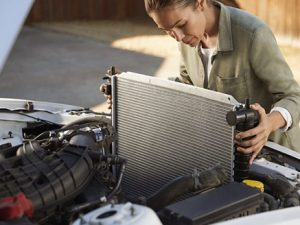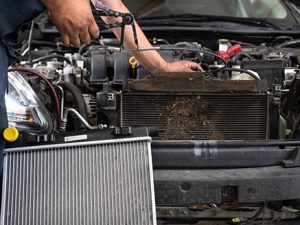Table of Contents
- Understanding the Role of the Radiator
- Signs That You Need to Upgrade Your Car Radiator
- Reasons to Upgrade Your Radiator
- Types of Radiators for Upgrading
- Steps to Upgrade Your Car Radiator
The radiator is an essential component of your car’s cooling system, tasked with keeping the engine at an optimal temperature. As your vehicle ages, or if you start pushing it harder (such as in performance or towing situations), the need for a more efficient radiator becomes clearer. This article will guide you through when and why upgrading your car’s radiator is necessary, helping you understand the benefits of making this change.
Understanding the Role of the Radiator

Before delving into when and why to upgrade your radiator, it’s important to understand its role in your car’s engine cooling system. The radiator’s primary job is to disperse heat absorbed from the engine. The coolant, which flows through the radiator, absorbs heat from the engine’s core and then releases it into the air via a series of metal fins. This process keeps your engine from overheating and ensures it runs at optimal temperatures.
Signs That You Need to Upgrade Your Car Radiator
Over time, the efficiency of your radiator can decline, or your car may require more cooling capacity depending on your driving habits and the demands placed on your engine. Here are some key signs that indicate it might be time to consider an upgrade:
| Sign | Reason |
|---|---|
| Overheating Engine | Your radiator may not be able to dissipate enough heat. |
| Frequent Coolant Leaks | If the radiator is leaking coolant, it’s often a sign of wear. |
| Poor Performance After Modifications | Upgrades such as a turbocharger may need a more powerful radiator. |
| Heavy Towing or Racing | These activities generate extra heat and stress the radiator. |
| Visible Damage | Cracks or corrosion on the radiator or fins can reduce efficiency. |
| Sluggish or Hesitant Engine Start | Overheating affects engine performance, especially during warm starts. |
| Unusual Engine Noise | Overheating can cause knocking, which may signal insufficient cooling. |
Reasons to Upgrade Your Radiator

Upgrading your radiator can significantly improve your vehicle’s cooling system performance and protect the longevity of your engine. Here are several reasons why you might consider upgrading your radiator:
1. Enhanced Cooling Capacity
Modern or upgraded radiators are often made from more efficient materials that provide better heat dissipation. For example, aluminum radiators are much lighter and more effective at transferring heat than older copper ones. This allows for more efficient cooling, particularly in high-performance situations like towing, racing, or driving in hot climates.
2. Improved Durability and Longevity
A high-quality radiator upgrade can increase the overall durability of your car’s cooling system. If your current radiator is corroded, leaking, or clogged with debris, an upgrade can prevent more serious engine damage caused by overheating. Newer radiators are built to last, with corrosion-resistant coatings and materials that can withstand harsh driving conditions.
3. Increased Engine Efficiency
By improving the cooling capacity, an upgraded radiator can help keep your engine running at optimal temperatures for better performance and fuel efficiency. Engines that run too hot may suffer from reduced performance, higher fuel consumption, or even long-term damage. A better radiator helps maintain the perfect engine temperature, maximizing efficiency.
4. Adaptability for Performance Modifications
If you’ve modified your car’s engine for more horsepower, such as adding a supercharger, turbocharger, or upgraded fuel system, your stock radiator may not be able to handle the additional heat produced. An upgraded, high-performance radiator will help keep temperatures under control and prevent overheating caused by the additional power.
5. Improved Towing and Heavy-Duty Use
If your vehicle is regularly used for towing or hauling heavy loads, the additional stress placed on the engine increases the likelihood of overheating. Upgrading to a larger radiator or one designed specifically for towing can enhance your vehicle’s cooling capacity and prevent engine damage in high-demand situations.
Types of Radiators for Upgrading
When considering an upgrade, it’s important to know the various types of radiators available and their benefits. The most common materials for radiators are aluminum, copper, and plastic. Let’s break down each type to understand their advantages and disadvantages:
| Radiator Type | Material | Advantages | Disadvantages |
|---|---|---|---|
| Aluminum Radiators | Aluminum | Lighter, better heat dissipation, corrosion-resistant | Can be more expensive |
| Copper Radiators | Copper | High thermal conductivity, long-lasting | Heavier, more prone to corrosion |
| Plastic-Aluminum Radiators | Aluminum & Plastic | Cost-effective, lightweight, readily available | Plastic parts may wear or crack over time |
| Dual-Core Radiators | Aluminum or Copper | Increased heat dissipation capacity for high-performance vehicles | More expensive, heavier |
| Crossflow Radiators | Aluminum | More efficient airflow, increased cooling for larger engines | Can be larger in size, may require more space |
Steps to Upgrade Your Car Radiator
Upgrading your car radiator is a relatively straightforward task, but it requires some basic knowledge of your vehicle and the necessary tools. Here’s a simple guide to help you through the process:
1. Identify the Need for an Upgrade
- Before beginning the upgrade process, make sure your current radiator is no longer functioning effectively or that your car’s modifications require better cooling performance.
2. Choose the Right Radiator
- Based on your car model, driving habits, and cooling needs, select an appropriate upgraded radiator. Consider factors like material, size, and compatibility with your engine.
3. Gather the Necessary Tools and Materials
- Basic tools you’ll need:
- Wrenches and sockets
- Screwdrivers
- Hose clamps
- Coolant
- Radiator support brackets (if required)
- Drain pan for old coolant
- Ensure that you have a new radiator that is compatible with your car’s cooling system.
4. Drain the Coolant
- Before removing the radiator, safely drain the coolant from your vehicle by locating the radiator drain valve and using a pan to collect it.
5. Remove the Old Radiator
- Disconnect the radiator hoses and cooling fans.
- Unscrew the bolts securing the radiator in place and carefully remove it.
6. Install the New Radiator
- Position the new radiator and secure it with bolts.
- Reconnect the hoses and cooling fans, ensuring all connections are tight.
7. Refill Coolant
- Fill the radiator with the appropriate type of coolant as specified by your vehicle manufacturer.
8. Test the System
- Start your car and monitor the temperature gauge. Ensure the radiator is working efficiently and that the engine stays cool during operation.
Conclusion
Upgrading your car radiator is an essential step when your vehicle’s current system can no longer keep up with your engine’s cooling needs. Whether you’ve modified your engine for performance, frequently tow heavy loads, or have an aging radiator that needs replacement, upgrading can enhance your vehicle’s performance, efficiency, and longevity.
With the right radiator, you ensure that your engine runs at optimal temperatures, preventing overheating, reducing wear and tear, and ultimately extending the life of your car. Remember to choose a radiator that suits your driving needs and make the upgrade at the right time to avoid costly repairs or engine damage.